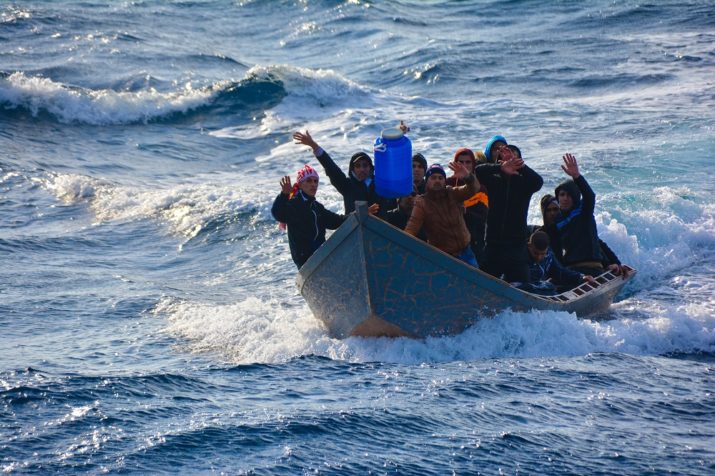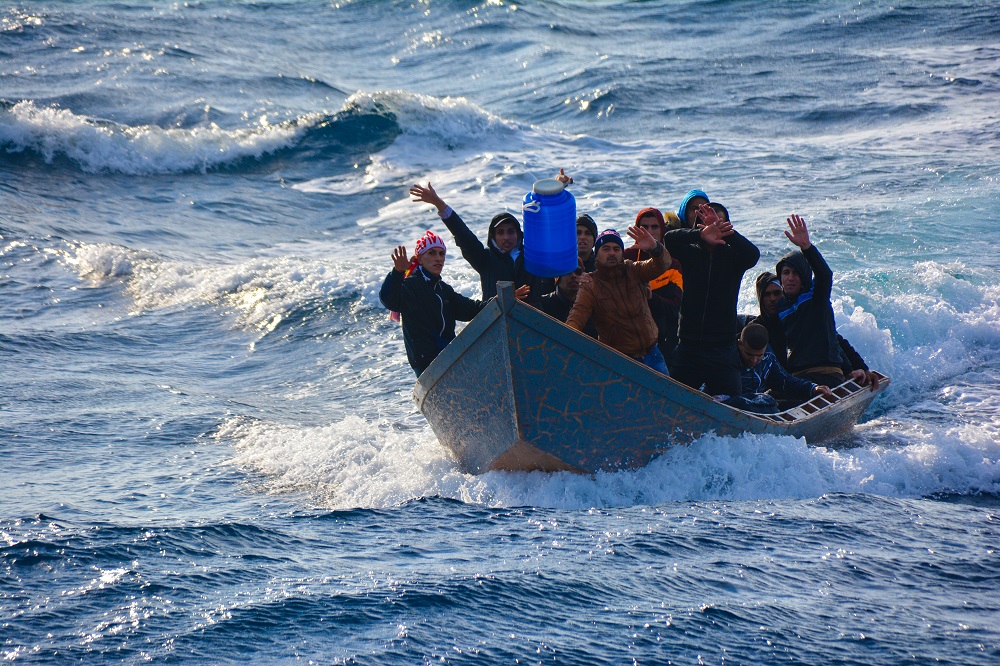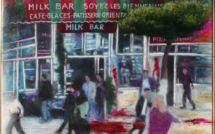
Behind the Humanitarian Crisis in the Mediterranean: Five Years After Lampedusa, Political Incoherence and Dysfunction Continues to Kill

This is part of our special feature, Beyond Eurafrica: Encounters in a Globalized World.
Certain historical incidents can crystallize and condense the reality of an entire era. The mass drowning of at least 500 migrants, mostly Eritrean,[1] near the island of Lampedusa on the third of October 2013, was one such incident. It was part of a wider set of political logics that characterize this era, logics that include those described by Barbara Pinelli in her ethnography of the conditions endured by asylum seekers in the reception centers of the Italian state (2015). For Pinelli, the conditions endured by survivors held in such centers are both inconsistent with human rights, and also rooted in an authoritarian political logic. Refugees’ conditions of imprisonment and repression are, she argues, rooted in an “institutional imaginary circulating within the camp,” which contradicts the putative humanitarianism of these camps’ creators, leading to a “long-term process of subjection” (Pinelli 2015: 12). Migrants, in other words, find themselves under the control of an apparently stable and coherent apparatus of control, surveillance, and repression, whose institutional features balance and support each other in a functional way. There is much in Pinelli’s argument with which we agree. Our point, however, is that her compelling ethnographic account of the abuse of power inside the camps has to be supplemented by an analysis of the inability of the receiving states in the European Union to produce a consistent, and collective, immigration policy. This failure has, above everything else shaped the evolution of the border that straddles the Mediterranean, and which cases so much human suffering and loss, suffering and loss that has only accumulated and worsened since we started analyzing the disaster off the island of Lampedusa, near the North African coast, but under European sovereignty, on October 3, 2013.
Specifically, the failure of a pan-European consensus on refugees and asylum seekers has led to repeated attempts to exclude them from Europe, attempts which have not only tried to tighten border controls, but which have also driven the already desperate to resort to ever more dangerous methods of evading those controls. More broadly, the condition of refugees in Europe today is the result of their entrapment in a network of authoritarianism that unites the European Union with repressive ‘Third World’ states. The fates of those who try to cross the Mediterranean border are conditioned by both the local conditions in their countries of origin, and by the fact that the supra-national entity whose borders they wish to cross, the European Union, has proven unable to evolve a coherent strategy for dealing with this crisis. This paper traces the consequences of that failure through an account of the Eritrean situation, local Lampedusan testimony regarding the third of October 2013, and through discussions of the contradictions of sovereignty in Eritrea and the EU, and the links between them. Our argument leads us to a pessimistic prognosis.
The Eritrean Disaster and the Politics of Desertion
Eritrea’s borders were first drawn, in 1889, by the Italian colonial regime. After the Second World War, the country was handed to Ethiopia; its people subsequently struggled for national independence from Ethiopia. This was won in 1991 and ratified in 1993. Five years later, the country found itself at war again with Ethiopia, and in the wake of that war, the Eritrean government unleashed a wave of terror and human rights violations against its opponents. This is what has created the powerful pressures which drive many people in Eritrea to an action so fraught with danger and risk, that of fleeing across deserts, borders, and seas.
The illegal crossing of the state’s borders by tens of thousands of people has provided certain economic opportunities for regime-connected individuals. State officials and army commanders operate a large network of services, including transportation and accommodation, for those able to afford the journey out under their auspices (Tecle and Hepner 2013; van Reisen et al. 2012). Human trafficking provide state functionaries with an additional income, and also acts as a political safety valve. Without it, the national service system would break down, due to the huge numbers of people who are trapped within it, and whom the system can no longer absorb.
Eritrean youth who flee repression and unending national service find that in the Diaspora, the regime “to (re)capture migrants economically and politically” (Tecle and Hepner 2013: 377). The state pursues Eritreans into the diaspora, by demanding a 2 percent tax[2], and harassing exiles who speak out against it. Eritreans living abroad also send remittances to their family in Eritrea, at a rate so high that they account for over 37 percent of the country’s GDP, in an African context where the average is 5 percent of GDP (Bernal 2015: 43 – 44). The regime, in other words, receives economic and political benefits from the policies that produce refugee flight. This does not mean however, that it is a coherent or stable regime: behind the façade of national unity lies a fractured society. Crisis can be deferred by migration, but it cannot be postponed indefinitely. In Eritrea, a façade of strength and unity hides a reality of political incoherence and stasis. That reality, also, is part of the European Union’s politics of migration, the other factor that has turned the Mediterranean not only into a border but also a battleground, one where the casualties are many and can only increase. Deaths at the border, which we describe in the next section, are the endpoint of long processes that led refugees to their fate – and these deaths are the result of the ways in which the border was formed, and of the links that stretch across it.
Lives Lost, Contradictions Revealed: October 3, 2013 on the Island of Lampedusa, and After
On the early hours of October 3, 2013, a few residents of Lampedusa were at sea in their boat off, when they heard faint sounds which they took, at first, to be seagulls. These were not the cries of seabirds, but the voices of people shouting for help. The Lampedusans started their boat’s engine and set course for the point they had identified as the source of the cries. It was already 6 am: the migrants’ boat, from which those cries came, had started to sink at 4:30. “Those moments will never be forgotten,” said one man whose friend first arrived at the scene. He reported that she suffered from post-traumatic stress for more than a year. She had saved a dozen Eritreans from the sea, but had also seen many others die, or already dead. Other local people and fishermen who were close by joined the rescue: “We could not save them all,” said one fisherman “Their bodies were so slippery from the oil they were covered in. It was difficult to grab them; it took us nearly an hour to save only 12 of them,” another man said. The coastguard, based a couple of miles from there, were called but had to fill their ships’ tanks before leaving for the rescuing operation. “This standard procedure takes at least 40 minutes,” according to member of Akavusa, a local cultural association.
Some of the Eritreans who survived were helped by the local population, some of whom offered them meals and their homes’ warmth. A cultural association, the Archivio Storico di Lampedusa, opened its doors to them during the day and sheltered them from the voracious eyes of journalists, who were, according to the Archivio’s president, “wandering around like sharks to interview the survivors who wanted nothing less than to find themselves in front of the cameras. A woman in her mid-forties who had hosted a few Eritreans said, “one of them took his shirt off, I then saw the scars of the slashes he had been inflicted while trying to get to Italy. . . I could feel the violence he had suffered.” People in Lampedusa find themselves confronted with such tragedies which they try in every way to handle but the “apparatus has come to an organizational point where nobody is allowed to intervene, the only way we can now have any contact with the people arriving by boat is to wave at them at the end of the dock where nobody can enter. We wave at them to welcome them while they sit on the bus that will bring them to the camp.” Nevertheless they say such organization does not make it more efficient: “it was better when people were given lifebelts to avoid drowning, we would then give them a warm plate of pasta and they would leave on another rickety boat once recovered.”
People in Lampedusa are suspicious of the Italian state and the European Union: some believe, for example, that this “crisis is wanted, to create a new economy, the economy run around the notion of emergency.” They believe that the border regime is growing and reinforcing itself from such tragedies, and that the apparatus supported by national and European authorities feeds from the notion of humanitarian crisis which allows a variety of NGO, state-run and EU structures to operate on the island. They are concerned, also, that their island is becoming an open air prison. One man told Arnone that he had counted 11 stations run by the military, the police, and the coastguard: this, on an island of 5,000 inhabitants.
There had been mass drowning events involving refugees and migrants in the Mediterranean before the night of the third of October, and there have been many since then, but the events of that night took on a new political significance. Pope Francis publicly condemned the tragedy as a matter of shame for those “responsible,” denunciation that echoed around the world. The fishermen and local people who did rescue most of the survivors cited in response the Italian “Bossi-Fini” migration law, which sanctions civilians who rescue people arriving from Africa on boats, accusing them of complicity in “illegal migration”. The Italian government, on its side, declared that Italy was being abandoned by the EU and the whole of Europe should be held responsible for the tragedy. The UN, in turn, called for steps “to prevent such tragedies in the future, including measures that address their root causes.”
Italy’s Prime Minister, Enrico Letta, announced that the migrants who died at sea would receive Italian citizenship. No comparable concession was made to the survivors, who were not allowed to attend the funerals of the victims buried in the cemeteries scattered in Sicily, or the state funeral in Agrigento, when the Italian ministers joined the Eritrean officials in a formal ceremony in memory of the dead. The survivors were instead detained in the Centro di Primo Soccorso e Accoglienza (CPSA), the rescue and reception center in Lampedusa. Built to hold people for mere days, the center held these survivors for up to three months. Luckily the CPSA in Lampedusa has a hole in its surrounding wire fence, through which people can “illicitly” exit. This way, they could make contact with local sympathizers of the kind quoted above. The obvious contradictions at work here underline the deformation of the migrants’ status: while the dead were to receive citizenship, the survivors were marginalized.
As for the Eritrean Government, it blamed not only human smuggling and trafficking and but also the UN sanctions on Eritrea and the lack of international support against Ethiopia over the 1998 – 2000 war. It claimed that it was only these factors, and not its own actions, to be responsible of the flight of thousands of young Eritreans. Italian officials then granted the Eritrean embassy officials were granted access to the asylum seekers in Lampedusa. A member of Askavusa said, “the mayor asked us to collect the Eritrean officials from the airport and bring them to the camp, I did not know that they were agents of the state from which the survivors were fleeing. I felt awful as I found out who they were and that they were allowed to photograph them and record their details.” Did the staff at the camp not realize that by letting such Eritrean officials in, they were placing their clients and their families in Eritrea in grave and immediate danger? It appears that they did not: and this only highlights the fact that the case documented by Pinelli is the final outcome of a mass of contradictions, which are not only produced by the failures of the Eritrean state, but also by those of the European Union.
Contradictions of Asylum for Persons and States
Migrants who cross the Mediterranean EU border either die by drowning, or survive to enter a legal limbo of uncertain duration. Invariably, the survivors find themselves trapped in the kinds of control so ably described by Pinelli (2015). The iniquities of surveillance are only one part of this case, however. Another lies in the fact that the Mediterranean sea has become a kind of border, one that separates the global North from the Global South, while at the same time uniting political systems in bothzones in ways that produce perverse outcomes.
Those outcomes are perverse because those systems are dysfunctional. The dysfunctions of the Eritrean regime have already been outlined above. Those of the EU, whose internal political contestations remain stubbornly national in character and orientation, also shape the border, and its lethal character. Nation-states persists within the shell of the European Union, and the decay of the European social model (Hermann 2014) has already led to the rise of the radical right as a political force in far too many European countries (Bustikova 2014: 1739). The rising threat of the far-right exploits perceptions of the “democratic deficit,” which remains a key weakness of the EU system[3] (Follesdal and Hix 2006). This primacy of the national, and of national politics is vitally important in relation to the ability of the European Union and its members to react to the refugee crisis in ways that might end or reduce the cost in human lives.
As the European project for unification through pooled sovereignty continued through the 1980s, the borders that separated EU member states gradually declined and, later, disappeared. At the same time, and for the same reasons, the need for a common policy to the guard the union’s collective border became more and more widely accepted (Mountz and Kempin 2014: 87). Yet attempts to collectively define and regulate that border proved fruitless. National governments defined their national interests in narrow terms, as the need to exclude as many migrants as possible, for fear of the rising political right. Their migration policies therefore sought to deter human trafficking, but these policies merely incited new tactics and strategies by human traffickers, who lacked no shortage of people to exploit: “[a]s enforcement in one area intensifies, human smugglers move elsewhere in search of entry points with less friction” (Mountz and Kempin 2014: 86). These new entry points may have less “friction,” but they are also far more dangerous. In other words, the policies whose intended purpose was to deter “illegal” migration have served only to increase the risk of mass drowning events and the death toll that comes with them.
The border that costs the lives of so many Eritreans who seek to cross it is a boundary which does act as a “container schema,” a division of space and people into the included and the excluded (Barth 2000: 28). What is crucial in this case is not only what is contained but what is connected: two political sovereignties, that of the State of Eritrea and the European Union. Both of these systems are dysfunctional in their own way, which is why they remain mired in apparently unending crisis. To understand this crisis, we think it is necessary to complement the focus with an understanding of sovereignty that moves beyond the simple paradigm of bare life as a product of sovereign power (Agamben 1998).
Conclusion
In 2015, the European Union announced that large sums of aid would be disbursed to Eritrea, in an attempt to staunch that country’s hemorrhaging of people (Blair 2015, Bereketeab 2016: 4). The effect of this aid, like the private sector aid that Eritrea has also attracted, will be to help stabilize that regime, to allow it to resist any pressures to reform, and to continue its long strategy of repression. This may well continue for some time to come, but eventually time will run out for the regime, as it ran out for similar systems before it. The longer the reckoning is delayed, the more likely that it will take a dark and destructive form.
In the face of this future threat, and present catastrophe, anthropologists will have to sound the alarm over such predictable outcomes. One of way doing that will involve Pinelli’s kind of ethnography. Another will be to understand the steps which led to such catastrophic events, steps rooted in particular ways of organizing sovereignty. That, in turn, will mean understanding experiments in sovereignty that have failed, and that have become united in perverse relationships that produce borders that kill.
David O’Kane is a Teaching Fellow at Durham University, UK, and a Research Partner of the Max Planck Institute for Social Anthropology, Halle/Saale, Germany. He has researched and published on issues of land reform and nationalism in Eritrea, and on the relationship between neoliberalism and education in post-civil war Sierra Leone. He is currently developing research interests in the connections between globalization and Emerging Infectious Diseases such as Ebola Virus Disease. He has taught in Ireland, Northern Ireland, Russia, the United Kingdom, New Zealand, and Sierra Leone.
Anna Arnone is a research associate at SOAS. In her work she explains the formation of Eritrean identities in circumstances of movement, dislocation and re-location from Eritrea to Italy. Her publications analyse the processual emergence of selfhood, critically considering the contextual and historical complexities involving individuals in processes of maintaining continuity, and constant re-articulation of the self with reference to the past and the future. Her focus on Eritrean mobility urges a critical thought about the impact of nation-state’s apparatuses and international regulations restricting human rights and influencing collective discourses of inclusion and exclusion when confronted with emergency situations.
Photo: Napoli – Italy – Circe january 2016 | Shutterstock
References
Agamben, G. 1998. Homo Sacer: Sovereign Power and Bare Life, Stanford; Stanford University Press.
Barth, F. 2000. ‘Boundaries and Connections’, pp. 17 – 36 in Cohen, Anthony P., ed., Signifying Identities: anthropological perspectives on boundaries and contested values. Routledge: London, New York.
Berekteab, R. 2016. ‘Eritrea’s Refugee Crisis and the Role of the International Community’. Nordic Africa Institute.
Bernal, V. 2015. Nation as Network: Diaspora, Cyberspace and Citizenship. The University of Chicago Press, Chicago and London.
Blair, E. 2015. ‘EU wants new Aid for Eritrea Soon to Help Stem Migrant Exodus’, https://uk.reuters.com/article/uk-europe-migrants-eritrea/eu-wants-new-aid-for-eritrea-soon-to-help-stem-migrant-exodus-idUKKCN0RH1MU20150917 Accessed 14.02.2018
Bozzini, D. 2011. “Low-tech State Surveillance: The Production of Uncertainty Among Conscripts in Eritrea.” Surveillance and Society vol. 9, no. 1/2 pp. 93 – 113.
Bustikova, L. 2014. ‘Revenge of the Radical Right’, Comparative Political Studies, vol. 47 no. 12, pp. 1738 – 1765.
Foucault, M. 1979 (1975) Discipline and Punish: The Birth of the Prison. Penguin Books, Harmondsworth.
Follesdal, A., and Hix, S. 2006. ‘Why There is a Democratic Deficit in the EU: a Response to Majona and Marovscik, Journal of Common Market Studies, vol. 44, no. 3, pp. 533 – 562.
Hermann, C., 2014. ‘Crisis, Structural Reform, and the Dismantling of the European Social Model(s)’, Economic and Industrial Democracy, vol. 38, no. 1, pp. 51 – 68.
Lord, C. 2008. ‘Still in Democratic Deficit’, Intereconomics, vol. 43, no. 6, pp. 316 – 340.
Mountz, A., and Kempin, R., ‘The Spatial Logics of Migration Governance along the Southern Frontier of the European Union’, pp. 85 – 96 in Walton-Roberts and Hennebry 2014. Territoriality and Migration in the EU Neighbourhood, Springer, Dordrecht.
Pinelli, B. 2015. ‘After the Landing: Moral Control and Surveillance in Italy’s Asylum Seeker Camps’, Anthropology Today, vol. 31, no. 2, pp. 12 – 14.
Tecle, S. and Goldring, L. 2013. “From ‘Remittance’ to ‘Tax’: the Shifting Meanings and strategies of capture of the Eritrean transnational party-state.” African and Black Diaspora: An International Journal, vol. 6, no. 2, pp. 189 – 207.
Tecle, S. and Redeker Hepner, T. 2013. “New refugees, development-forced displacement, and transnational governance in Eritrea and exile.” Urban Anthropology, vol. 42, no. 2-3, pp. 377 – 410.
UNICEF, 2018. ‘Refugee and Migrant Crisis in Europe: Humanitarian Situation Report 26. No place of publication.
Van Reisen, M., Estefanos, M. and Rijken, C., 2012. Human trafficking in the Sinai: Refugees between life and death. Nijmegen: Wolf Publishers
Wilson, T.M., and Donnan, H. 1998. Border identities: nation and state at international frontiers. Cambridge: Cambridge University Press
[1] Out of the 368 people who died when the boat capsized on the night of the third of October 2013, 360 were Eritreans. The authors have been involved in Eritrean scholarship for many years, hence their interest in this particular incident, which they see as emblematic of a wider criminal situation.
[2] For historical perspectives on this aspect of the current Eritrean situation see, for instance, Tecle and Goldring 2013 and Bernal 2014.
[3] The concept of the ‘democratic deficit’ has been variously defined, but it largely refers to the gap (real or perceived) between the officials of the European Union, and those whom they putatively represent (Lord 2008). In the case of the European Commissioners, who are appointed by the governments of the member states, there is a widespread perception that on taking up their posts they become ‘”creatures of the system”, a system over which little democratic control can be exercised. Essentially, the concept involves the perception that citizens of EU member states cannot exercise meaningful democratic control over the EU. Such perceptions, whether exaggerated or not, play a key role in the current wave of radical right-wing politics in the EU, and especially in Eastern Europe (Bustikova 2014: 1752). Any future Europe which has been remade according to the radical right’s politics of vicious chauvinism will not be an improvement on the EU in its current condition, whatever the flaws of that condition might be.
Published on March 1, 2018.




